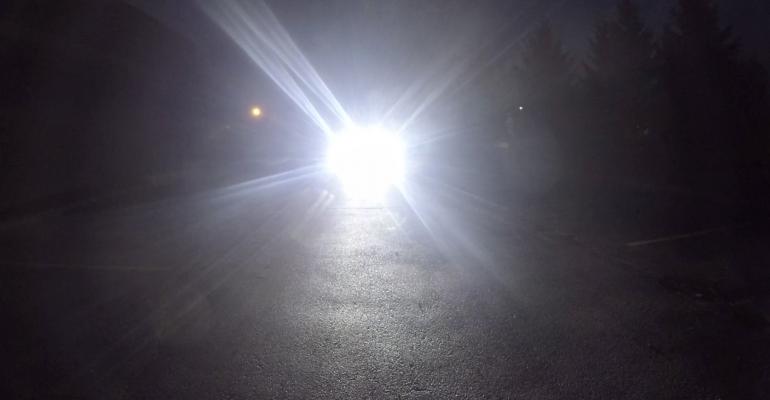PLYMOUTH, MI – One month after talking up the technology at the SAE World Congress in Detroit, supplier Varroc Lighting Systems demonstrates for media its always-on high-beam technology.
Adaptive Drive Beam can turn off a select number of individual LEDs in an array to create a shadow around an oncoming vehicle. But the high-beam functionality never is turned off, leaving the sides of the road brightly illuminated and creating what Varroc says is a safer driving environment.
“You may think, ‘Oh, I’ve created a dark box so I’m not going to have good visibility here,’ but the benefit is the oncoming car has its own lights and fills in the dark zone, so you still get basically all the illumination (you normally would), it’s just a coupling between your vehicle and the oncoming vehicle,” Scott Montesi, director-product development for Varroc, tells media here during a demonstration at the lighting supplier’s Detroit-area headquarters.
A shadowbox also can be created around preceding vehicles so glare is reduced in rearview and side mirrors.
The secret to the technology, which uses no mechanical parts, is a camera and software code.
Adaptive drive beam can use the same camera already installed in a vehicle to detect lane markings for advanced-safety systems. When light is sensed, code instructs certain LEDs in the array to dim.
Due to the hassle of having to switch between low and high beams with conventional headlight units, Montesi estimates high beams are used just 10%-15% of the time during nighttime driving in the U.S.
“Generally consumers just leave (high-beam mode) off because they don’t want to have to be bothered by having to turn it on and off. This system will do that for you,” he says.
This type of technology, available from other lighting suppliers as well, is just emerging in Europe. Montesi estimates just 2%-3% of vehicles there have it. Varroc will supply an unnamed European automaker with ADB within the year.
NHTSA currently is evaluating the robustness of the technology in Europe before permitting it on U.S. vehicles.
FMVSS108 has requirements for low-beam and high-beam performance, but it doesn’t allow for a mixing of the two lighting modes.
“NHTSA wants to make sure under different driving scenarios that (ADB) doesn’t unintentionally glare at oncoming traffic or someone in front of them,” Montesi says.
In various nighttime tests here of an ADB-equipped Audi A6, WardsAuto notes the technology performs as expected numerous times, as seen in the above video, including on a busy curving road.
However, brightly lit shoulders could take some getting used to for drivers, who normally cannot see the level of detail ADB provides.
Paul Lyon, engineering manager-Varroc, believes consumer preference will play a role in ADB’s acceptance, should it be approved for U.S. use. Any vehicle equipped with ADB in the U.S. likely would retain a conventional, driver-selectable low-beam mode.
Because the ADB-connected-camera only detects light, oncoming bike riders or walkers who do not illuminate themselves at night could face glare.
With U.S. approval, Varroc says the technology could be available here as soon as late 2017 or early 2018.





